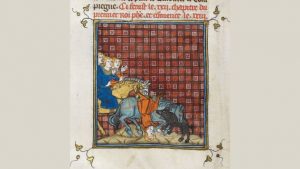 Music
Music  Music
Music  History
History 10 Less Than Jolly Events That Occurred on December 25
 Weird Stuff
Weird Stuff 10 Funny Ways That Researchers Overthink Christmas
 Politics
Politics 10 Political Scandals That Sent Crowds Into the Streets
 Weird Stuff
Weird Stuff Ten Bizarre Facts About The Doge Meme
 Our World
Our World 10 Ways Your Christmas Tree Is More Lit Than You Think
 Movies and TV
Movies and TV The 10 Coolest Stars to Set Sail on The Love Boat
 History
History 10 Things You Didn’t Know About the American National Anthem
 Technology
Technology Top 10 Everyday Tech Buzzwords That Hide a Darker Past
 Humans
Humans 10 Everyday Human Behaviors That Are Actually Survival Instincts
 Music
Music 10 Surprising Origin Stories of Your Favorite Holiday Songs
 History
History 10 Less Than Jolly Events That Occurred on December 25
 Weird Stuff
Weird Stuff 10 Funny Ways That Researchers Overthink Christmas
Who's Behind Listverse?

Jamie Frater
Head Editor
Jamie founded Listverse due to an insatiable desire to share fascinating, obscure, and bizarre facts. He has been a guest speaker on numerous national radio and television stations and is a five time published author.
More About Us Politics
Politics 10 Political Scandals That Sent Crowds Into the Streets
 Weird Stuff
Weird Stuff Ten Bizarre Facts About The Doge Meme
 Our World
Our World 10 Ways Your Christmas Tree Is More Lit Than You Think
 Movies and TV
Movies and TV The 10 Coolest Stars to Set Sail on The Love Boat
 History
History 10 Things You Didn’t Know About the American National Anthem
 Technology
Technology Top 10 Everyday Tech Buzzwords That Hide a Darker Past
 Humans
Humans 10 Everyday Human Behaviors That Are Actually Survival Instincts
10 of the Most Unusual Deaths Ever Recorded in History
How do you think you will die? It’s a morbid question, sure. But one thing is for certain about this life: we’ll all leave it at one point or another. And for most of us, we’ll not only have very little control over how we die but also where and when. Sure, we’d love to think we’ll die peacefully in our sleep in our 80s or 90s after a long, fulfilling life. But the truth is that death comes for us in all kinds of scenarios and at all kinds of different times.
That’s what this list is about today. In these next ten tidbits, we’ll dive into some very unusual and unexpected deaths throughout history. For these people, they could forget about dying in their sleep or with family members and loved ones surrounding them. No, no. In their case, death came in bizarre, macabre, and truly unique ways. These are ten of the most unusual deaths ever recorded in human history!
Related: 10 Death-Related Festivals Around the World
10 Manius Aquillius & (Maybe) Marcus Licinius Crassus
Manius Aquillius was a consul in the late Roman Republic era. In 90 BC, he was sent to Asia Minor by his leaders to restore Nicomedes IV of Bithynia to his kingdom. Nicomedes had been expelled from rule by Mithridates VI of Pontus, and the Romans wanted him back in charge.
When he got to Asia Minor, Aquillius promptly encouraged Nicomedes to raid part of Mithridates’s territory in a bid to take back power. That kicked off the First Mithridatic War, which at the time was one of the most vicious and violent fights in history. During the war, Aquillius was captured by Mithridates’s men.
Not surprisingly, they were peeved that he was the one who had encouraged all the bloodshed in the name of restoring Nicomedes to his throne. So they brought Aquillius to Mithridates himself. Incensed at the Roman consul for his work in starting the war, Mithridates had Aquillius executed in a horrific way: he poured molten gold down the consul’s throat and let the man choke and burn up in a terrible and painfully slow death. (And an expensive death, at that!)
Speaking of expensive deaths, there is a longtime legend that a Roman general and statesman named Marcus Licinius Crassus also met his end with molten gold being poured down his throat. During his life, he was called “the richest man in Rome,” but apparently, all the mortal riches weren’t enough for him.
During the Battle of Carrhae in 53 BC, he was defeated and captured by the Parthians. They hated his greed and lust for money. So they supposedly executed him in a way befitting his mortal desires: by pouring molten gold down his throat in open mockery of his obsession for wealth.[1]
9 Saint Lawrence
Saint Lawrence was one of the seven deacons of the city of Rome during his lifetime in the third century AD. Born in about 225, he entered the church early and rose to high posts as an adult. Then, in the year 258, he was martyred in one of the most horrific ways possible. It came amid the persecution of Christians under the Roman emperor Valerian.
As a deacon in Rome, Lawrence was responsible for presiding over the material goods of the church. He was also tasked with giving alms to the poor. One day in 258, the prefect of Rome showed up at Lawrence’s door and demanded that he bring forward the church’s treasures for inspection. Well, Lawrence admitted what he’d done: He’d given away the treasures to the poor as alms. He felt they would be better helped by the material comfort than just stashing expensive things, jewels, and riches away in the church coffers.
Predictably, the prefect was furious with Lawrence for actually having the audacity to help the poor—especially at the expense of the church. So, with Valerian on the warpath, he ordered Lawrence to be executed. The prefect’s charges put together a massive gridiron-style grill and laid Lawrence upon it. They lit hot coals underneath the grill and literally barbecued Lawrence to death on the white-hot iron.
Now, legend has it that as he was being martyred for his faith and his desire to help the poor, Lawrence supposedly said to his executioners something along the lines of “This side’s done, turn me over and have a bite.” Historians today think that quote is likely apocryphal, but it’s certainly funny. And it earned Saint Lawrence the patronage of cooks, chefs, and comedians alike after his martyrdom and death.[2]
8 Philip of France

Philip of France was just 13 years old in 1129 when he was crowned as the king of France. He wasn’t the official and sole king, though. Even after his coronation, he was set to co-reign with his father, Louis VI. The doting dad wanted to prepare his son for the monarchy later on after Louis VI inevitably died. But sadly, just two years into their co-reign, Philip was killed. And the manner in which he died was both grisly and a once-in-a-million-years run of bad luck.
It happened on October 12, 1131. As a 15-year-old boy, Philp was out doing what 15-year-old boys tend to do: horsing around. Literally. He was riding a horse along a path that ran down the Seine River in Paris on a strand of land named the Greve. He and his friends all had horses, racing and chasing each other through the muddy path.
Well, at one point, they came up to a quay. And in the quay, there was a massive black dung heap. The boys moved around to ride past it, but suddenly, a black pig rushed out of the dung heap. It ran right in front of Philip’s horse and tripped the much bigger animal, which never saw the black pig speeding out of the black dung.
The horse fell forward, and Philip was launched over its head. He catapulted down onto the ground. From that height and at that speed, he was severely injured, and he immediately fell unconscious. Sadly, he died the next day without ever regaining consciousness. His family was, of course, devastated.
Not only did they lose their first-born son, but they lost the rightful heir to the throne in a tragic manner, at only 15 years old. And it all came about in the most unlikely of ways: a black pig rushing out of a black dung heap at just the worst possible time and at the worst possible angle. What are the odds?[3]
7 Charles the Bad
Charles II, also known by his charges in Spain as Charles the Bad, was the king of Navarre from 1349 until his death in 1387. He wasn’t old when he passed on January 1 of 1387—just 55 years of age—but he was in ill health and had been for a long time. He wanted to be cured of his persistent maladies, so he summoned his physician to his bedroom.
There, he ordered the doctor to sew him up tightly in his bed sheets and soak the linen in distilled wine. That was supposed to fix whatever ailed him. That was what passed for medical care in the 14th century, apparently. But it wasn’t medical care in Charles’s case at all. Instead, it led directly to his death.
A nurse had painstakingly sewn up the sheet very carefully with a string. Then, she was supposed to cut the final bit of loose string from the end to allow Charles to lay there in the distilled spirits for a while to heal. Well, she couldn’t find a knife or anything else suitable to cut the final string and let Charles rest and heal. So she lit a candle and carried it over to the bed. She was going to burn off the end of the string and finish her job efficiently and cleanly.
You can probably predict what happened next. The alcohol-soaked sheets caught fire after they came into contact with the candle. The fire spread extremely quickly, and it couldn’t be put out. Charles was burned alive and unable to escape since he’d been sewn into the sheets and couldn’t quickly maneuver his way out of the mess.
In mere minutes, Charles the Bad went from a mostly disliked ruler to an entirely dead one. And through the direct fault of himself, as he’d ordered the sewing and “treatment.” As for his subjects in Navarre and others around both Spain and France, he was a deeply unpopular ruler for many people, so his macabre death coming at his own hand was seen as God’s wrath being placed upon a despotic king.[4]
6 Pietro Aretino

Pietro Aretino was an Italian playwright and poet who lived a fascinating life in the early 16th century. He was one of the most influential writers of his time and a deeply cutting satirist. He was incisive and vicious in making fun of the powerful and the political leaders of his day.
He also made many enemies for his writings—and for the fact that he wasn’t above using blackmail to coerce people and get his way. He was popular with regular people, though, as they felt like he held a torch to the feet of the powerful and made them uncomfortable and unsettled.
On October 21, 1556, when Aretino was 64, he went to a dinner party in Venice. There, he apparently had a wonderful time eating, drinking, and being merry with friends. Then, somebody told a joke, and when they delivered the punchline, Aretino began to fall over in wild fits of laughter. His laughter got so intense, the story goes, that it killed him!
Supposedly, Aretino died while wheezing and struggling to find air after laughing so hard at the joke that he couldn’t fill his lungs with oxygen. We wonder what the joke was; hopefully, the punch line was worth it! In reality, Aretino likely died from a heart attack or perhaps a stroke. It is also possible he was poisoned, as some historians believe he would have made enough enemies to be on the hook for something like that.
But for what it’s worth, it is actually possible to die of laughter. It’s very, very rare, but laughing too much and too intensely for too long can technically lead to asphyxia and then death. Did that happen in Aretino’s case? We’ll never truly know. But it is certainly the persistent legend around his sudden and unexpected passing.[5]
5 Tycho Brahe
During his life through the latter half of the 16th century, Tycho Brahe was one of the most intelligent and pioneering astronomers on earth. Even today, his work is foundational for people studying the stars, the moon, and deep space. That makes it all the more shocking to learn how he died in 1601.
Brahe was attending a banquet in Prague in October of that year, and he wanted to be around for the entire show. He had to pee really badly, according to fellow astronomer Johannes Kepler’s first-hand account. Still, Brahe felt that leaving the banquet even briefly to go to the bathroom was an unpardonable breach of etiquette. So he held it in—for hours, and hours, and hours.
Eventually, things got so bad that Brahe came down with a kidney infection or possibly a serious bladder ailment. When he got home, his body was in such dire straits that he was no longer even able to urinate at all. Over the next eleven days, he could only pee in extremely small quantities, and only then with unbelievable pain pushing through his body. Then, on October 24, less than two weeks after the banquet, he died in complete and total agony. He was just 54 years old.
Today, historians wonder whether he could have possibly passed following the effects of a kidney stone. Some others have suggested that mercury poisoning could have been the culprit. However, the general assumption is that Brahe’s death was caused by a fatal cause of uremia that was exacerbated by an inflamed prostate. And perhaps that death may serve as an important reminder to the rest of us now: when you’ve gotta go, you’ve gotta go![6]
4 François Vatel
François Vatel was a French chef in the 17th century who, at one point, served as the majordomo to elites in society, including Nicolas Fouquet and the famed general-slash-prince Louis, Grand Condé. Among Vatel’s achievements in the culinary realm, he is credited with creating Chantilly cream, which to this day is enjoyed as a sweet, vanilla-flavored whipped topping.
Vatel was meticulous in his care for what the French high society needed at balls, dinners, feasts, and other functions. And he had carved out a notable career for himself, feeding and catering to the whims of the upper crust of the highest class. In fact, he was so taken with making sure that the elites had what they needed to feel good that it ended up killing him.
In April 1671, Vatel was responsible for putting together a banquet for more than 2,000 people. The banquet was supposed to honor King Louis XIV and be done in the name of the Grand Condé. So, to say that Vatel had to get things right was an understatement. The Grand Condé’s reputation depended on the banquet being a hit. The pressure was on to rightly honor the king and do so in a way that showed grace, class, and humility.
Unfortunately for Vatel, the fish arrived late at the banquet. It was so late, in fact, that the majordomo himself turned incredibly distraught over the slight. He was so torn up on the inside over the fact that the fish wouldn’t have time to be prepared satisfactorily for the 2,000 guests that he literally killed himself over it.
Vatel went into another room, grabbed his sword, and ran it through his body. He died alone there amid the incredible disappointment over the fish showing up late to the show. His body was found not long after when an attendant walked into the room to tell him that the fish had arrived. But for Vatel, it was too late.[7]
3 Archduchess Mathilde of Austria

Archduchess Mathilde Marie Adelgunde Alexandra of Austria was born in 1849 with very high hopes from her family. She was a member of the House of Habsburg-Lorraine. As the daughter of Archduke Albert, Duke of Teschen, she had the bloodline that could help make her a very important player in the world of European royalty.
She was so important, in fact, that by the 1860s, she was being set up to become the Queen of Italy. The plan was for her to marry King Umberto I, and the betrothed couple would rule Italy together for the rest of what should have been a long and prosperous life. That’s not how things actually happened, though.
On June 6, 1867, Mathilde was killed in a horrific accident, the details of which are difficult to believe. At about 6:00 p.m. that day, she died at Hetzendorf Palace in the city of Vienna. Her cause of death involved her trying to hide a cigarette she’d been smoking from her father.
She was wearing a gauze dress at the time, having put it on to go to the theater that night. Then, she lit a cigarette to smoke. Well, Archduke Albert arrived unexpectedly, and he didn’t want his daughter smoking. Mathilde panicked, and she quickly hid the lit cigarette behind her. Tragically, the gauze caught fire almost immediately, as it was very flammable. In seconds, the entire dress lit up, and she was suddenly aflame.
In front of her entire family, Mathilde accidentally self-immolated. She suffered second and then third-degree burns on most of her body. The dress’s material even burned into her skin, leaving her in excruciating pain. Doctors were called, and the fire was eventually put out, but there was little that anybody could do for her.
Mathilde died several hours later, still in total agony. She was just 18 years old—and whatever might have been for her life and her planned move to Italy was immediately and shockingly halted forever.[8]
2 Clement Vallandigham
Clement Laird Vallandigham was a well-known American lawyer born in 1820 who rose to prominence during the Civil War. He was the leader of a so-called “Copperhead” faction of Democrats who were against the war and wanted to resolve the dispute between North and South in peace.
From his high-profile anti-war position, he served two terms as a Congressman representing Ohio’s 3rd district. Then, in 1863, he was expelled from the North and exiled to the Confederate States of America for being a Democrat and not supporting the Union cause during the war. But while his life as a politician and anti-war activist may be interesting, the real shocker is how Vallandigham died.
On June 17, 1871, he was back in Lebanon, Ohio, after being reinstated to the area in the years following the end of the Civil War. On that day, he was representing a defendant in court named Thomas McGehean. Thomas was being accused of murder for allegedly killing another man in a barroom brawl.
Vallandigham’s defense was that the other man, Tom Myers, had actually shot himself by accident, and it wasn’t McGehean at all who was responsible for the murder. And Valladingham had the ultimate proof to back it up: he was going to show in court, with an actual gun, exactly how Myers would have shot himself during the fracas in the bar.
When he showed up at court that day, Vallandigham took a pistol—which he thought was unloaded—and stood up before the jury. He put the pistol in his pocket and relayed the events of the brawl as he believed they might have happened. In the end, he grabbed the loaded gun in his clothing and showed how Myers might have shot himself. Unfortunately for Vallandigham, the gun went off. It discharged straight into his stomach in front of the judge and jury.
Vallandigham was fatally wounded in the incident, dying hours later of peritonitis from the pistol ball. It was good news for McGehean, though. Vallandigham’s defense convinced the jury that Myers, indeed, could have accidentally shot himself in exactly that same matter, and McGehean was acquitted.[9]
1 The Thanksgiving Day Disaster
On Thanksgiving Day in 1900, Stanford University and the University of California, Berkeley faced off in what is known annually as “The Big Game.” That college football rivalry has been going on for decades, and even back then, it was billed as a massive affair.
After all, the two schools were only a few miles apart in the Bay Area, and the alumni of one college didn’t have too much of an affinity for the grads of the other. The November 1900 game proved to be a massively important match for each school, too, so it was held in a neutral stadium in San Francisco.
The game was a sellout, but many more people wanted to watch it than there were tickets available. While the cheapest seats were going for $1 (the equivalent of somewhere around $40 today), many people either didn’t have that money or didn’t want to fork it over for a college football game. Instead, they felt like they could see the game for free—from the roof of a glass-blowing factory across the street.
Hundreds of people went up onto the roof and could look down into the stadium and see the game for free. Sadly, you can probably guess what happened next.
The roof collapsed in on itself, and more than 100 people fell four stories down to the factory floor. At that point, the scene became like something from a Final Destination movie. More than 60 people fell on top of the furnace, which was running with surface temperatures around 500°F (260°C). For those who didn’t die from the unsurvivable furnace blast, some of the rest were killed in the fall itself.
The roof collapse also severed a series of fuel pipes and oil lines. They sprayed many of the victims with scalding hot oil. Then, all that fuel in the factory ignited, and a fire broke out. The fire was so vicious and so hot that it claimed the lives of even more people and also charred many of the already-dead bodies beyond recognition.
In the end, 23 people were killed, and over 100 more were severely injured. To this day, it is the deadliest accident ever to occur during a sporting event in America. Honestly, it was a surprise that it wasn’t far worse.[10]








